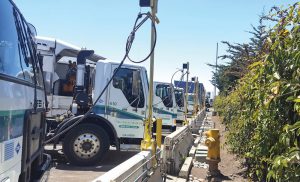Paul Greene
Biogas project developers and financiers are finding strong offtake opportunities selling their gas into the California Low Carbon Fuel Standard (LCFS) market. This trend is driving a wave of new facility construction to make renewable natural gas (RNG).
The LCFS stems from California legislation focused on climate mitigation, particularly through control of short-lived climate pollutants such as methane gas. In addition to driving biogas opportunities, the LCFS opens markets for other fuels like biodiesel, corn ethanol, and hydrogen, while also spurring development and use of electric, hydrogen and natural gas vehicles.

In-state RNG projects, such as this anaerobic digestion facility in South San Francisco, are eligible under the LCFS for either self-use, direct sale as a conventional fuel replacement, or by injecting into a pipeline and demonstrating RNG use as a vehicle fuel. Photo by Sabrina Bortoli
LCFS Origins
California is the second largest consumer of petroleum products in the nation and the largest consumer of motor gasoline and jet fuel, according to a November 2018 U.S. Energy Information Administration analysis (EIA, 2018). As a state that is particularly susceptible to the impacts of climate change, and having the necessary political and public will, California has placed itself at the forefront of U.S. climate legislation, particularly as it relates to its transportation fuel portfolio.
With passing of the California Global Warming Solutions Act of 2006 (AB 32) and initiation of California Cap and Trade, the California Air Resource Board (CARB) began its LCFS program in April 2009 to meet goals of reduction of greenhouse gas emissions to 1990 levels by the year 2020. This program was fully implemented in 2011, with amendments approved in 2013, and with subsequent 2015 re-adoption that became effective in 2016. In July 2017, AB 398, which included amendments to AB 32, expanded the cap and trade and LCFS programs out to 2030, and with even higher goals — namely 40 percent reduction against the baseline. It passed with strong bipartisan approval.
The LCFS program is designed to decrease the carbon intensity (CI) of California’s transportation fuels by providing a mechanism to introduce a range of low carbon and renewable fuel alternatives. The program works by requiring fuel companies to achieve CI targets by either producing lower CI fuel or purchasing credits from lower CI fuels sold in the California market. Original targets, as identified in Executive Order S-1-07, detail a program requiring CI reduction of at least 7.5 percent and 10 percent in California’s transportation fuels by 2019 and 2020, respectively. In attempts to make the program more realistic, 2018 amendments now require reductions of 6.25 percent and 7.5 percent for 2019 and 2020, while mandating full 20 percent reduction by 2030.
LCFS Compliance And Trading
The heart of the LCFS compliance and trading system involves four key variables: Pathway by which the fuel is generated; Carbon Intensity (aka “CI Score”) of a fuel; Reference fuel being replaced; and Overall price per ton of carbon.
Pathway
The pathway covers the fuel’s life cycle from well to final pump and maps out a process journey for the exploration, feedstock collection, conversion, upgrading, transportation, distribution, and filling practices for a given fuel. Pathways are unique for a given feedstock and conversion system, such as anaerobic digestion of manures, food scraps, or biosolids, with a subsequent gas upgrading system to produce RNG. The RNG may be used for fueling on-site or introduced to a pipeline distribution network accessible to the California transportation market. Applications for a pathway must be completed and approved by CARB using verified, project-specific performance data before credits can be received by the project.
Carbon Intensity Score
The CI value is calculated by compiling all the carbon emitted along the supply chain for that fuel including all the carbon used to (where applicable) explore, mine, collect, produce, transport, distribute, dispense and burn the fuel. The units tied to a CI score are grams of CO2 equivalent emitted per megajoule of energy, or gCO2e/MJ. The score is then adjusted for energy economy rate (EER) to produce a final EER-adjusted CI score that quantifies the emissions from the use of alternative fuel per MJ of conventional fuel displaced. CARB has developed the simplified CI calculator to facilitate the process of generating CI scores (see Box).
Reference Fuel Replacement
All renewable fuels and their carbon intensity are compared to a reference fuel being replaced — typically either conventional gasoline or diesel — that has an assigned value that is updated each year. To be eligible for generating credits, renewable fuels must have CI values below the CI of the fuel being replaced. Some renewable fuels have extremely low CI scores. A pathway for at least one project where RNG is generated from anaerobic digestion of dairy manure and will replace diesel fuel, for example, has an assigned CI of a negative (-)250 gCO2e/MJ. Compared to the CARB assigned average CI of 82.87 for diesel as a reference fuel for 2020 to 2030, the project will generate average LCFS credits during that 10-year period based on the 332.87 point differential from the reference fuel. Such low, or negative, CI scores are possible for some feedstocks and pathways since they both offset use of conventional fuels and mitigate methane releases from a present baseline emission.
Other common CI scores include corn ethanol of 70 gCO2e/MJ; landfill gas generally scores about 10-20 gCO2e/MJ; and biodiesel scores about 50 gCO2e/MJ. Each of these scores, being greater than zero, indicate they still are net emission generators, but the fact that their scores are below the reference fuels indicates they are better for the environment and consistent with the goals of the LCFS program.
Price Per Ton
As of this writing the price per LCFS credit is $198/ton (CARB, 2019). This price is one component of the business proposition for both the developer producing the RNG fuel and the obligated party purchasing credits to meet continually increasing state CI targets.
Putting It Together
Using a pathway with extremely low, or negative CI value, such as anaerobic digestion of dairy manure to RNG, the large differential between that pathway and the reference fuel generates more LCFS credits and potential trading value. Based on current LCFS credit market values, this translates to a value for the dairy manure RNG project of wellover $50/MMBTU, more than 15 times the present NYMEX (New York Mercantile Exchange) value of pipeline fossil natural gas at $3/MMBTU. (An MMBTU is one million British thermal units, a measure of the energy content in fuel.)
The California LCFS program credit value can dramatically increase the project’s value, incentivizing development and ongoing production. In-state projects are eligible for either self-use or direct sale as a conventional fuel replacement, or by injecting the RNG into a pipeline and demonstrating ultimate use as vehicle fuel. For RNG produced out of state to qualify for LCFS credits, the RNG must be sold to a company that supplies fuels into the California transportation market that has either dispensing facilities or a vehicle fleet in California. Out-of-state projects can qualify their RNG for LCFS credits if the gas is injected into a natural gas pipeline with the ability to flow to California.
Some concerns exist around the potential for market saturation, especially as large municipal users of RNG, such as city buses, reach full conversion of their vehicles to natural gas fueling, or with anticipated future technology improvements, e.g., switching to electrical or hydrogen powering. Because the number of credits generated is in comparison to the actual fuel replaced, a project where RNG replaces fossil natural gas or grid-supplied electricity will not generate the same number of credits as one where diesel is replaced.
2018 LCFS Amendments
Overall market demand for RNG is under the watchful eye of CARB, which has some ability to adjust the LCFS program to perceived market needs, as was recently done with 2018 amendments. One such amendment is approval of a new RNG pathway for LCFS credits that ties into operations of petroleum refineries. These refineries use significant amounts of natural gas that, until now, has come from fossil sources. As a result of 2018 amendments to the LCFS program, these refineries can now use RNG to reduce the carbon intensity of their production process, and hence the CI of the conventional fuel produced. Natural gas is a key feedstock in refinery processes such as the steam methane reformers (SMR) in the refinery. SMRs create hydrogen, which is a chemical intermediate for the hydrocrackers and hydrotreaters that produce gasoline and diesel fuel. Using RNG rather than fossil gas reduces the carbon footprint of these operations.
This “Renewable Hydrogen” pathway, as it is known, is creating a good, new, strong long-term offtake opportunity for RNG, mitigating some emerging concerns about market demand. Note that since this pathway does not involve the direct fueling of a vehicle it does not allow for generating federal RIN credits via the Renewable Fuel Standard (RFS). This pathway should not be confused with use of hydrogen for vehicle fuel. This hydrogen is a chemical intermediate in the refining of petroleum gasoline and is not used for vehicle fueling.
The California LCFS is its own, state driven program. RNG generated either in-state or out-of-state can be sold into this market. There are other strong markets that can provide additional financial incentives for biogas projects as well. The federal RFS, for one, is an additional market that provides good opportunities for offtake (see “101 For RINs,” November 2017). These are driven by the trading of RIN credits, which are like the Renewable Electricity Credit market for electricity. This monetization of RINs is in addition to monetizing LCFS credits — allowing for an extra incentive and further monetization.
In A Nutshell
Overall, California’s LCFS program has shown strong growth over time, which has resulted in a strong, stable and reliable offtake market for biogas project developers. Recent studies have highlighted that from 2011-2018, the LCFS program has led to $2.8 billion in capital investment both in and outside the state of California (California Delivers, 2018) along with the following benefits:
- Over 20,000 jobs in the state of California alone
- 74 percent increase in use of renewable fuel within the state, with a corresponding reduction in 3.7 billion gallons of petroleum fuel
- Estimated $2 billion in avoided health care costs, primarily through air quality enhancements
- Reduction of 38 million metric tons of CO2eq, equivalent to a removal of 6.4 million cars from the roads of California.
With an eye on these results, Oregon created its Clean Fuels Program, while others, like Washington State, have proposed similar legislation. Recent studies by Oregon (ORDOE, 2018) and Washington (WADOC, 2018) show potential for near- to medium-term production, within each state, of approximately 80 to 90 million gasoline gallon equivalents (GGE) per year of RNG fuel or roughly 3 to 4 percent of their current fossil natural gas demand.
Paul Greene is Director of Project Management for Montrose Environmental, a national provider of construction, troubleshooting and operations services for digester biogas projects. He holds his BS in Chemical Engineering and was the first founding Chairman of the American Biogas Council (pgreene@montrose-env.com). Contributions to this article were provided by Craig Frear, Regenis; Norma McDonald, OWS; and Sean Mezzei, Dekany Consulting.













